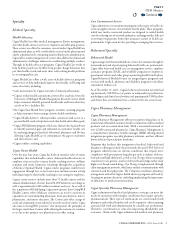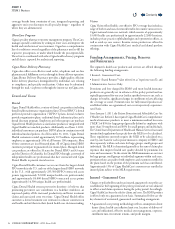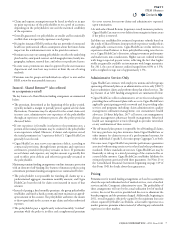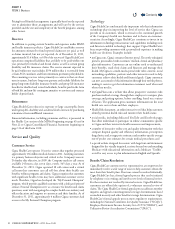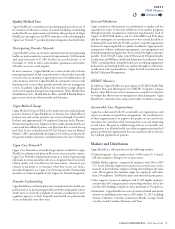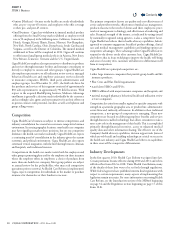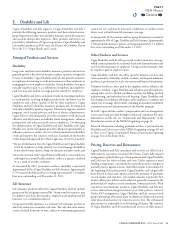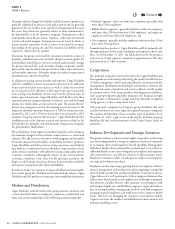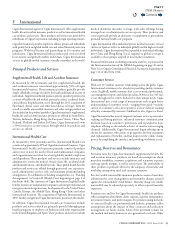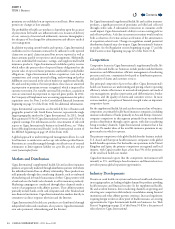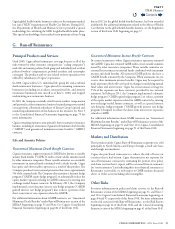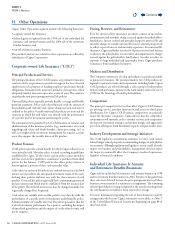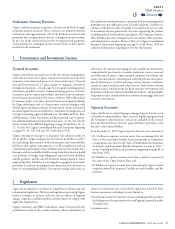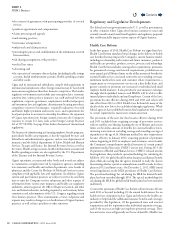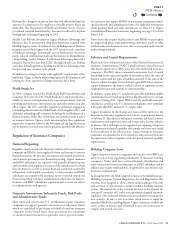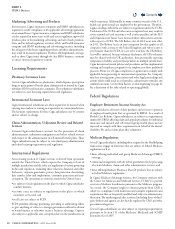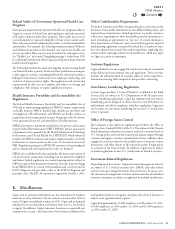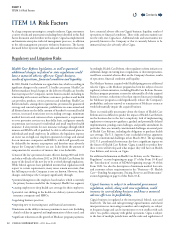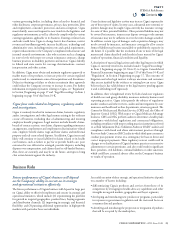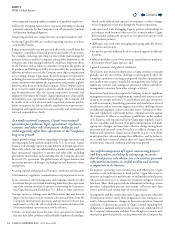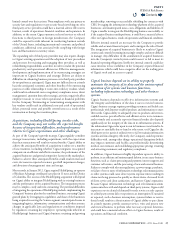Cigna 2011 Annual Report Download - page 37
Download and view the complete annual report
Please find page 37 of the 2011 Cigna annual report below. You can navigate through the pages in the report by either clicking on the pages listed below, or by using the keyword search tool below to find specific information within the annual report.
15CIGNA CORPORATION2011 Form10K
PARTI
ITEM 1 Business
Cigna’s global health benets business is subject to the minimum medical
loss ratio (“MLR”) requirements of Health Care Reform. During 2011,
the Department of Health and Human Services provided a special
methodology for calculating the MLR for global health benets plans.
is special methodology, that resulted in no premium rebates being
due in 2011 for the global health benets business, has been extended
indenitely. For additional information related to the eects of Health
Care Reform on the global health benets business, see the Regulation
section of this Form10-K beginning on page17.
G. Run-off Reinsurance
Principal Products and Services
Until 2000, Cigna oered reinsurance coverage for part or all of the
risks written by other insurance companies (or “ceding companies”)
under life and annuity policies (both group and individual) and accident
policies (workers’ compensation, personal accident, and catastrophe
coverages). e products and services related to these operations were
oered by subsidiaries of Cigna Corporation.
In 2000, Cigna sold its U.S. individual life, group life and accidental
death reinsurance businesses. Cigna placed its remaining reinsurance
businesses (including its accident, international life, and annuity
reinsurance businesses) into run-o as of June1,2000, and stopped
underwriting new reinsurance business.
In 2010, the Company essentially exited from its workers’ compensation
and personal accident reinsurance business by purchasing retrocessional
coverage from a Bermuda subsidiary of Enstar Group Limited and
transferring administration of this business to the reinsurer. See Note3
to the Consolidated Financial Statements beginning on page79 for
more information.
Cigna’s remaining exposures stem primarily from its annuity reinsurance
business, including its reinsurance of guaranteed minimum death benets
(“GMDB”) and guaranteed minimum income benets (“GMIB”)
contracts.
Life and Annuity Policies
Guaranteed Minimum Death Benefit Contracts
Cigna’s reinsurance segment reinsured GMDB (also known as variable
annuity death benets (“VADBe”)), under certain variable annuities issued
by other insurance companies. ese variable annuities are essentially
investments in mutual funds combined with a death benet. Cigna
has equity and other market exposures as a result of this product. e
Company purchased retrocessional protection that covers approximately
5% of the assumed risks. e Company also maintains a dynamic hedge
program (“GMDB equity hedge program”) to substantially reduce the
equity market exposures relating to GMDB contracts by entering into
exchange-traded futures contracts. In February2011, the Company
implemented a new dynamic interest rate hedge program (“GMDB
growth interest rate hedge program”) that reduces a portion of the
short-term interest rate exposures related to GMDB.
For additional information about GMDB contracts, see “Guaranteed
Minimum Death Benets” under Run-o Reinsurance section of the
MD&A beginning on page51 and Note6 to Cigna’s Consolidated
Financial Statements beginning on page82 of this Form10-K.
Guaranteed Minimum Income Benefit Contracts
In certain circumstances where Cigna’s reinsurance operations reinsured
the GMDB, Cigna also reinsured GMIB under certain variable annuities
issued by other insurance companies. ese variable annuities are
essentially investments in mutual funds combined with minimum
income and death benets. All reinsured GMIB policies also have a
GMDB benet reinsured by the Company. When annuitants elect to
receive these minimum income benets, Cigna may be required to
make payments which will vary based on changes in underlying mutual
fund values and interest rates. Cigna has retrocessional coverage for
55% of the exposures on these contracts, provided by two external
reinsurers. In February2011, the Company implemented a dynamic
hedge program (“GMIB equity hedge program”) to reduce a portion
of the equity market exposures related to GMIB contracts by entering
into exchange-traded futures contracts, as well as a partial interest
rate dynamic hedge program (“GMIB growth interest rate hedge
program”) designed to reduce the short-term interest rate exposures
related to GMIB.
For additional information about GMIB contracts, see “Guaranteed
Minimum Income Benets” under Run-o Reinsurance section of the
MD&A beginning on page51 and Note10 to Cigna’s Consolidated
Financial Statements beginning on page91 of this Form10-K.
Markets and Distribution
ese products under Cigna’s Run-o Reinsurance segment were sold
principally in North America and Europe through a small sales force
and through intermediaries.
Cigna also purchased reinsurance to reduce the risk of losses on
contracts that it had written. Cigna determines its net exposure for
run-o reinsurance contracts by estimating the portion of its policy
and claim reserves that it expects will be recovered from its reinsurers
(or “retrocessionaires”) and reecting these in its nancial statements as
Reinsurance recoverables, or, with respect to GMIB contracts discussed
above, as Other assets including other intangibles.
Other Risks
For more information on policy and claim reserves see the Run-o
Reinsurance section of the MD&A beginning on page51, and Notes7
and 10 to Cigna’s Consolidated Financial Statements beginning on
pages84 and 91respectively of this Form10-K. For more information
on the risk associated with Run-o Reinsurance, see the Risk Factors
beginning on page22 of this Form10-K, and the Critical Accounting
Estimates section of the MD&A beginning on page41 of this Form10-K.
Contents
Q


